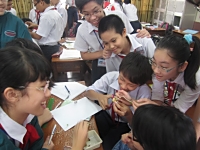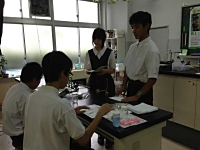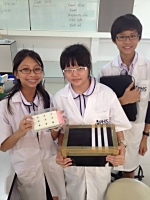This is an archive of information released in the past.
Disclaimer: It may contain broken links or outdated information. Some parts may not function in current web browsers.
*Visit https://humans-in-space.jaxa.jp/en/ for the latest information.

Expert commented on SSAF2013 student's reports
Dr. Kouichi Soga, associate professor of Osaka City University, reviewed SSAF2013 reports submitted by the students in Asia Pacific region. Dr. Soga is one of the leading scientists in plant gravitational biology and supervised the SSAF2013 mission.
"It is very gratifying that so many people took part in the Space Seeds for Asian Future (SSAF) 2013 mission and presented their experimental results. While reading these reports, I could easily imagine the scene where you were diligently working on your experiments through trial-and-error processes. Many photographs in the reports also tell that people were having good time doing experiment together.
SSAF2013 aims to see if there are any differences in sizes or shapes of seedlings by comparing Azuki bean seedlings grown on the ground and those grown in space. To examine how a plant changes its size and shape according to its environment, you have to be able to grow plants uniformly in sizes and shapes under each condition. Many of you might think that growing plants was very easy. In practice, however, I suppose that Azuki bean seedlings did not grow very well, as some seeds germinated while others didn't or some seedlings grew tall while others remained short. You might realize how difficult it is to carry out experiments using living organisms.

Vietnamese school children examine seedlings

Japanese high school students discuss on their results

Pile of reports submitted by Malaysian students
On the shape of seedlings, most teams reported that the stem extended different directions between on the ground and in space. On the other hand, views on the size differed. The more teams reported that seedlings grew bigger in space. Not only the gravity, but other factors, such as light, temperature and moisture, also affect the sizes and shapes of plants. To strictly examine the effect of gravity on the plant's shape and size, you have to keep factors other than gravity as same as possible among the experimental groups. In the present experiment, you have found that plant grew differently in size and shape in space. How plants change their shapes and sizes, then? Let us plan a new experiment to find the cause and try to do it." (Translated by KUOA from original message in Japanese)
Dr. Soga also pointed out that this program provided great educational effect and should be continued involving larger number of students.
- Growth and Morphogenesis of Azuki Bean Seedlings in Space during SSAF2013 Program
- https://www.jstage.jst.go.jp/article/bss/28/0/28_6/_article
| Copyright 2007 Japan Aerospace Exploration Agency | Site Policy |

